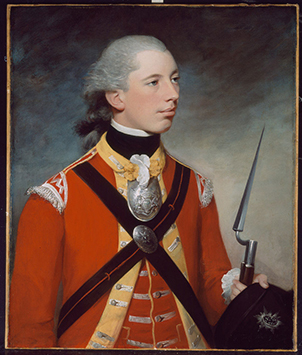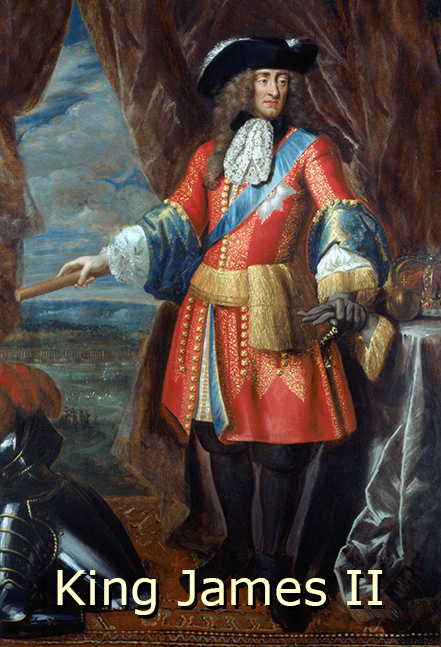 In 1685, King James II was compelled to add new regiments of horse and foot to those already in being, to deal with Monmouth’s Rebellion. Under the date of 20 June 1685, a commission was issued to Major General John Granville, Earl of Bath, for the raising of eleven companies of foot, each containing 100 “private men.” These companies, added to the independent company of infantry in the Plymouth garrison, constituted a regiment, of which the Earl of Bath was appointed Colonel, and which became known as the Earl of Bath's Regiment of Foot. The men for the new regiment were raised in the counties of Derby and Nottingham. The first uniform was a single-breasted, long skirted blue coat lined with red, with red waistcoat, breeches and stockings.
In 1685, King James II was compelled to add new regiments of horse and foot to those already in being, to deal with Monmouth’s Rebellion. Under the date of 20 June 1685, a commission was issued to Major General John Granville, Earl of Bath, for the raising of eleven companies of foot, each containing 100 “private men.” These companies, added to the independent company of infantry in the Plymouth garrison, constituted a regiment, of which the Earl of Bath was appointed Colonel, and which became known as the Earl of Bath's Regiment of Foot. The men for the new regiment were raised in the counties of Derby and Nottingham. The first uniform was a single-breasted, long skirted blue coat lined with red, with red waistcoat, breeches and stockings.
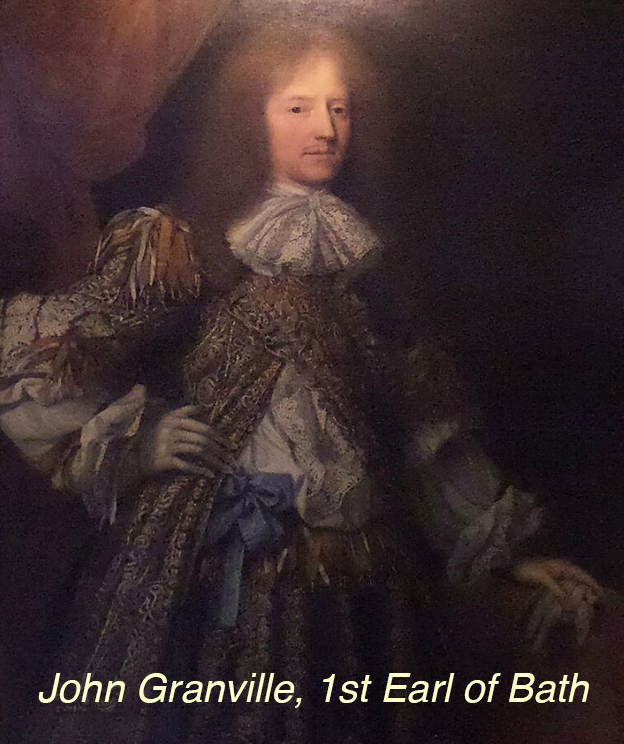 Monmouth’s Rebellion ended quickly, before the Regiment was ready for service, thus the Regiment first saw active service in the war of the Grand Alliance, taking a prominent part in the Battle of Steenkirk (Flanders) during the War of the League of Augsburg in 1692. The Regiment then saw service in the Nine Years War (1688 - 1697) and the War of Spanish Succession (1701 - 1715), but did not take part in the Seven Years War (1756 - 1763). Service in the campaigns of Marlborough during the War of the Spanish Succession in the battles of Blenheim, Ramillies, Oudenarde and Malplaquet lead to the Regiment's first Battle Honours.
Monmouth’s Rebellion ended quickly, before the Regiment was ready for service, thus the Regiment first saw active service in the war of the Grand Alliance, taking a prominent part in the Battle of Steenkirk (Flanders) during the War of the League of Augsburg in 1692. The Regiment then saw service in the Nine Years War (1688 - 1697) and the War of Spanish Succession (1701 - 1715), but did not take part in the Seven Years War (1756 - 1763). Service in the campaigns of Marlborough during the War of the Spanish Succession in the battles of Blenheim, Ramillies, Oudenarde and Malplaquet lead to the Regiment's first Battle Honours.
From 1715 - 1730, the Regiment remained stationed in Britain. In 1730, the Regiment was transferred to Gibraltar where it remained until 1749 at which time it was moved to Ireland, a posting that lasted until 1767.
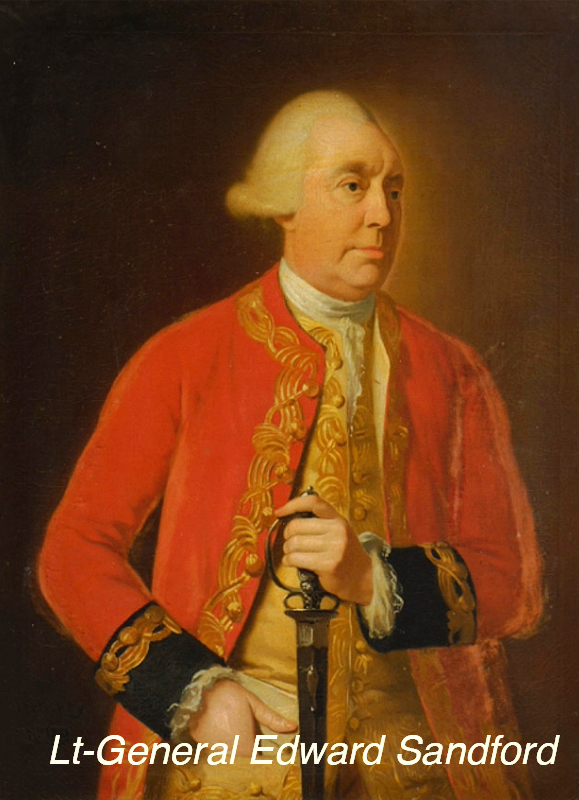 The practice of calling Regiments of Foot by the names of their Colonels ceased in 1751 and numbers were allotted; the Earl of Bath's Regiment became His Majesty's Tenth Regiment of Foot. On 14 January 1763 King George III conferred the colonelcy on Major- (eventually Lieutenant-, 1770) General Edward Sandford from the 26th Foot who remained in England throughout his appointment, which ended upon his death in 1781.
The practice of calling Regiments of Foot by the names of their Colonels ceased in 1751 and numbers were allotted; the Earl of Bath's Regiment became His Majesty's Tenth Regiment of Foot. On 14 January 1763 King George III conferred the colonelcy on Major- (eventually Lieutenant-, 1770) General Edward Sandford from the 26th Foot who remained in England throughout his appointment, which ended upon his death in 1781.
"Colonels" of the Regiment through the American War for Independence
| Rank | Name | Begin | End |
| Colonel | John Granville 1st Earl of Bath |
31 Dec, 1685 | 8 Dec., 1688 |
| Colonel | Sir Charles Carney1 | 8 Dec., 1688 | 31 Dec., 1688 |
| Colonel | John Granville 1st Earl of Bath2 |
31 Dec, 1688 | 28 Oct., 1693 |
| Lieut.-General | Sir Beville Granville | 29 Oct., 1693 | 14 Jan., 1703 |
| Lieut.-General | William North 6th Lord North & Grey |
15 Jan., 1703 | 22 June, 1715 |
| Lieut.-General | Henry Grove | 23 June, 1715 | November, 1736 |
| Lieut.-General | Francis Colombine | 27 July, 1737 | 22 Sep., 1746 |
| Field Marshal | James O'Hara 2nd Lord Tyrawley (Lord Kilmaine) |
22 Dec., 1746 | 9 Aug., 1749 |
| Lieut.-General | Edward Pole3 | 10 Aug., 1749 | 22 Dec., 1762 |
| Major / Lieut.-General | Edward Sandford4 | 14 Jan., 1763 | 9 Oct., 1781 |
| Lieut.-General | Sir Robert Murray Keith KB | 10 Oct., 1781 | 22 June, 1795 |
1An Irish Jacobite loyal to King James II. The Lieut.-Colonel of the Regiment appointed by James II to replace the Protestant John Granville as Colonel.
2Reappointed as Colonel upon King James II being deposed by William and Mary.
3First Colonel of the Regiment designated as: His Majesty's Tenth Regiment of Foot.
4Colonel of the Regiment during its service in North America (1767 - 1778). Remained in England during that time.
Officers Commanding the Regiment through the American War for Independence 5
| Name | Begin | End |
| Sir Charles Carney | 1685 | 1688 |
| Sir Beville Granville | 1688 | October 1693 |
| Sidney Godolphin | October 1693 | 1696 |
| Henry Rawley | 1696 | 1706 |
| Henry Grove | 1706 | 1711 |
| Francis Colombine | 1723 | October 1735 |
| Francis Smith6 | February 1762 | 10 Aug., 1781 |
5It was common for the Regimental Colonel to not be on station with his regiment. Thus, the battalion would be under the direct command of another officer, typically with the rank of Lieutenant-Colonel. NOTE:The above table is incomplete and may be inaccurate. Much of the information comes from Richard Cannon's Historical Record (ISBN 10:1014945798) published in 1848.
6Commanding Officer (Lieut.-Colonel) of the Regiment during its service in North America and the American War for Independence (1767 - 1778). Commanded the combined force that marched to Concord on April 19, 1775.
The Regiment in North America and the American War for Independence (1767 - 1778)
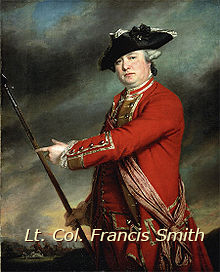 Under the command of Lt Col. Francis Smith, the Regiment sailed from Cork Haven, Ireland on 3 June 1767 to North America arriving at Port Lévis, Quebec in August. In 1772, The 10th Foot was moved to the Great Lakes region to garrison Fort Niagra, Fort Oswegatchie, Detroit, and Michilimackinac (Mackinaw City, MI). While at the latter post, the men of the Regiment worked to complete the government storehouse inside the fort and built a boat launch to move canoes and bateuas. They may have rebuilt one of the fort walls as well.
Under the command of Lt Col. Francis Smith, the Regiment sailed from Cork Haven, Ireland on 3 June 1767 to North America arriving at Port Lévis, Quebec in August. In 1772, The 10th Foot was moved to the Great Lakes region to garrison Fort Niagra, Fort Oswegatchie, Detroit, and Michilimackinac (Mackinaw City, MI). While at the latter post, the men of the Regiment worked to complete the government storehouse inside the fort and built a boat launch to move canoes and bateuas. They may have rebuilt one of the fort walls as well.
 To the right are two 10th foot buttons found at Michilimackinac. The upper, pewter button is from the uniform of a rank-and file soldier, the lower, silver button from an officer's uniform. The buttons currently used by the recreated 10th are based on such examples. (Source: Colonial Michilimackinac)
To the right are two 10th foot buttons found at Michilimackinac. The upper, pewter button is from the uniform of a rank-and file soldier, the lower, silver button from an officer's uniform. The buttons currently used by the recreated 10th are based on such examples. (Source: Colonial Michilimackinac)
The Regiment received orders to return to England in early 1774 and thus the Great Lakes forts were turned over to the 8th Foot and the Regiment set off for Nova Scotia. However, upon arrivial, the Regiment learned that there was to be a change in plans and the Regiment, in response to General Gage's call for reinforcements in Boston, would not be returning to England afterall. Thus the Regiment embarked for Boston on 8 October 1774, arriving on 3 November. The battalion was encamped on Boston Common with the officers being quartered around the town.
On April 18-19, 1775, Lieut-Colonel Smith commanded a combined force of ~800 men consisting of flank companies (Grenadiers and Light Infantry) assembled from among the regiments garrisioned in Boston to march to Concord . Their mission was to seize military supplies being stockpiled therein by the Colonial militia. The 10th Grenadier and Light Infantry Companies were part of that force, the Lights taking part in the skirmishes at Lexington Green and Concord's North Bridge, both companies engaging in the battle back to Boston. The Battalion Companies were at the relief of the troops on the night of the 19th when they arrived back in Cambridge. These events have become known as the first engagements of the American Revolution.
During the War of American Independence the 10th Foot took part in the battles of Bunker's Hill and Long Island, plus the Invasion of Manhatten Island and the battles of Germantown and Monmouth. Their last major action of the war was in August 1778 at the defense of Newport and Quaker Hill Rhode Island. In the fall of 1778, the Regiment was ordered back to England and as such, the officers, serjeants and drummers set sail for home on September 25, 1778. The rank and file men, still fit for service, remained in America to be "drafted" as replacements among the various regiments still active in the war. Those returning to England arrived in December, after having been away from the home soil since 1730, and immediately set about rebuilding the Regiment. (*See Historical Note to the left).
 To the right is the commission for Andrew Cathcart Esq. appointing him Major and Captain to "His Majesty's Tenth Regiment of Foot." The document is signed by Sir Henry Clinton and dated 29 June 1778, the day after the Battle of Monmouth Court House and three months before the Tenth Regiment was drafted home. Click on the image for a larger view. (Image kindly provided by Douglas Neumann, owner of the document)
To the right is the commission for Andrew Cathcart Esq. appointing him Major and Captain to "His Majesty's Tenth Regiment of Foot." The document is signed by Sir Henry Clinton and dated 29 June 1778, the day after the Battle of Monmouth Court House and three months before the Tenth Regiment was drafted home. Click on the image for a larger view. (Image kindly provided by Douglas Neumann, owner of the document)
The Regiment after North America
The territorial connection to the County of Lincoln commenced with an order dated 31 August 1782, in which the 10th Foot was directed “to take the county name of the 10th or North Lincolnshire Regiment and be looked upon as attached to that division of the County.
 The Regiment played a prominent part in the war with Revolutionary France and the Peninsular War. For its services in the campaign against Napoleon in Egypt, it was granted authority to use the Sphinx as its badge.
The Regiment played a prominent part in the war with Revolutionary France and the Peninsular War. For its services in the campaign against Napoleon in Egypt, it was granted authority to use the Sphinx as its badge.
 In 1804, Mr. William Pitt devised a scheme for the raising of 31,000 men additional to the establishment of the Regular Army. These men were formed into second battalions for the Regular regiments. Thus the 2nd Battalion of the 10th first came into being at Maldon. The new battalion saw service in the ill-fated Walcheren Expedition and in Sicily, being disbanded in Malta in 1816 on reduction of the Army.
In 1804, Mr. William Pitt devised a scheme for the raising of 31,000 men additional to the establishment of the Regular Army. These men were formed into second battalions for the Regular regiments. Thus the 2nd Battalion of the 10th first came into being at Maldon. The new battalion saw service in the ill-fated Walcheren Expedition and in Sicily, being disbanded in Malta in 1816 on reduction of the Army.
The next active service seen by the 10th was in the Sikh Wars of 1846-49, special distinction being gained for gallantry at the Battle of Sobraon. In 1857 the Indian Mutiny broke out and the 10th was actively engaged in its suppression.
 The image to the left is the leather toilet case of Capt. John Edmund Whaite, 10th North Lincolnshire Regiments circa 1849. (Source: National Army Museum, London; NAM. 1959-09-179-1)
The image to the left is the leather toilet case of Capt. John Edmund Whaite, 10th North Lincolnshire Regiments circa 1849. (Source: National Army Museum, London; NAM. 1959-09-179-1)
 When a Lieutenant in the 10th North Lincolnshire Regiment, Lieutenant-General Sir Henry Marshman Havelock-Allan Bt VC (right) was awarded the Victoria Cross for his actions at Cawnpore on 16 July 1857. Lt. Havelock lead a charge by the men of the 64th straight into the muzzle of a 24-pounder resulting in the capture of the piece. He was killed on 30 December 1897 by Afridi sniper-fire during Sir William Lockhart's expedition to the Khyber pass. (Source: National Army Museum, London; NAM. 1956-04-18-1)
When a Lieutenant in the 10th North Lincolnshire Regiment, Lieutenant-General Sir Henry Marshman Havelock-Allan Bt VC (right) was awarded the Victoria Cross for his actions at Cawnpore on 16 July 1857. Lt. Havelock lead a charge by the men of the 64th straight into the muzzle of a 24-pounder resulting in the capture of the piece. He was killed on 30 December 1897 by Afridi sniper-fire during Sir William Lockhart's expedition to the Khyber pass. (Source: National Army Museum, London; NAM. 1956-04-18-1)
 In 1857, owing to the state of affairs in India, the Government decided to augment the Army. Accordingly the 2nd Battalion once again came into existence, its formation being completed in Ireland in 1858. In 1881, the infantry of the Army was organized into Territorial districts, the 1st and 2nd Battalions of each being Line, and the remainder Militia. The old numbers were abolished and each regiment was to bear a Territorial designation corresponding to the locality with which it was connected. Thus the 10th North Lincolnshire Regimemt became The Lincolnshire Regiment.
In 1857, owing to the state of affairs in India, the Government decided to augment the Army. Accordingly the 2nd Battalion once again came into existence, its formation being completed in Ireland in 1858. In 1881, the infantry of the Army was organized into Territorial districts, the 1st and 2nd Battalions of each being Line, and the remainder Militia. The old numbers were abolished and each regiment was to bear a Territorial designation corresponding to the locality with which it was connected. Thus the 10th North Lincolnshire Regimemt became The Lincolnshire Regiment.
 The 1st Battalion saw service in the Nile Expedition of 1898, and two years later the 2nd Battalion in South Africa. To the left, Men of the 1st Battalion man a makeshift line prior to the battle at Omdurman (2 September 1898) during the 2nd Sudan War. (Source: National Army Museum, London; NAM. 1985-05-13-14)
The 1st Battalion saw service in the Nile Expedition of 1898, and two years later the 2nd Battalion in South Africa. To the left, Men of the 1st Battalion man a makeshift line prior to the battle at Omdurman (2 September 1898) during the 2nd Sudan War. (Source: National Army Museum, London; NAM. 1985-05-13-14)
However, all of these previous campaigns were overshadowed by the Great War in which nineteen battalions of the Regiment saw service. That the Regiment played a noble part is seen by the following list of battle honours borne on the Regimental Colour: -- “Mons”, “Marne 1914”, “Messines, 1914, ’17, ’18", “Ypres, 1914, ’14, ’17", “Neuve Chapelle,” “Loos,” “Somme, 1916, ’18", “Lys”, “Hindenburg Line”, “Suvla.”

During the 1930's the 2nd Battalion of the Lincolnshires was stationed in Palestine acting as peacekeepers while the 1st Battalion had their share of incidents when they were part of the Shanghai International Defence Force. The 1st Battalion was in India and the 2nd in England when WWII broke out. There were six Lincolnshire Battalions during this war from 1939-1945. From Norway and Iceland, to India and Burma, they fought.
The 2nd and 6th Battalions fought in France before battling their way to Dunkirk. The 1st Battalion had a splendid record against the Japanese in Burma. The 6th Battalion fought with distinction in Tunisia and Italy. The 2nd and 4th Battalions fought bravely in the Normandy landings and the subsequent North West European drive to the Rhine.

 The Regiment won numerous battle honours during the War but the most prized distinction came in December 1946 when, by Special Army Order, they were notified that King George VI had been graciously pleased to authorize the regiment to be known by the style and title of “The Royal Lincolnshire Regiment.”
The Regiment won numerous battle honours during the War but the most prized distinction came in December 1946 when, by Special Army Order, they were notified that King George VI had been graciously pleased to authorize the regiment to be known by the style and title of “The Royal Lincolnshire Regiment.”
The 1st and 2nd Battalions were merged in 1948 and the new reconstituted Battalion fought well in Malaya against the Communist terrorists. Their next posting was Aden and then Minden. There, in 1960, they learned that they were to be amalgamated with the Northamptonshires to form the new 1st Battalion, The 2nd East Anglian Regiment (Duchess of Gloucester's Own Royal Lincolnshire and Northamptonshire). On 7 October 1962, at Lincoln Cathedral, the Colours of the old 1st Lincolnshires were laid up just seven months short of their hundred years of service.
 In September 1964, The 2nd East Anglian Regiment was again amalgamated, this time with the 1st East Anglian Regiment, the 3rd East Anglian Regiment, and The Royal Leicestershire Regiment to form the The Royal Anglian Regiment, of which the former Lincolnshires & Northamptonshires constitute the 2nd Battalion. Still proudly known as “The Poachers”, the battalion has served Queen and Country in Cyprus, as part of the British Army of the Rhine, in Northern Ireland, and in Bosnia. Today they proudly serve the forces of freedom in Basra, Iraq.
In September 1964, The 2nd East Anglian Regiment was again amalgamated, this time with the 1st East Anglian Regiment, the 3rd East Anglian Regiment, and The Royal Leicestershire Regiment to form the The Royal Anglian Regiment, of which the former Lincolnshires & Northamptonshires constitute the 2nd Battalion. Still proudly known as “The Poachers”, the battalion has served Queen and Country in Cyprus, as part of the British Army of the Rhine, in Northern Ireland, and in Bosnia. Today they proudly serve the forces of freedom in Basra, Iraq.




